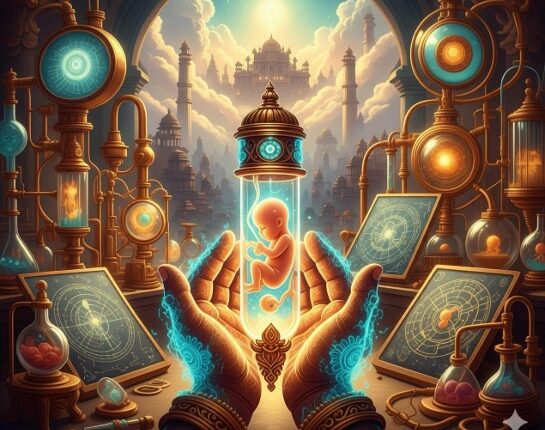BEFORE MODERN LABS: THE MAHABHARATA’S TEST TUBE BABY MYSTERY
In the modern world, science has advanced to such an extent that it is a literal boon for the entire universe. Modern science & technology have come up with various innovations to provide childless couples the happiness of having children through methods such as surrogacy or IVF (in-vitro fertilization), which also translates to ‘fertilization taking place outside the body’. Science has made everything that seemed impossible possible by incorporating advanced technologies into its processes over the years. So, when we talk about IVFs, we basically frame a picture in our mind about modern laboratories, experienced and specialized doctors, modern equipment, etc. But wouldn’t it be surprising if it is found out that the existence of these scientific procedures can be traced back right to the era of the Mahabharata? Interesting, right? So, the purpose of this blog is to explore the mystery of the Mahabharata’s test tube babies.
Aspect 1: The Unexplored Tale of Gandhari’s Pregnancy:
Gandhari, the wife of King Dhritarashtra (Emperor of the Hastinapur dynasty), experienced an unusual pregnancy period of almost two years, as mentioned in the epic, as the sage Vyasa blessed her to be the mother of 100 sons and one daughter. Contrary to the usual time period for women to give birth, which is 9 months, Gandhari’s pregnancy was unusually long. Slowly, this wait of 2 years turned her hopes into anxiety and frustration. Unable to wait any further, Gandhari struck open her own stomach in despair and was shocked to see what came out of her womb, A Huge Lump of Lifeless flesh! This left her totally confused and heartbroken.
Aspect 2: Sage Vyasa’s “Scientific “solution
Then, Sage Vyasa stepped in to resolve the confusion. He ordered the palace helpers of Hastinapur to cut the lump of flesh into 101 equal pieces and store them in clay pots filled with ghee and a mixture of herbs. All followed Sage Vyasa’s instructions, and each piece of flesh was stored in separate clay pots. Sage Vyasa assured Gandhari that with time, a child would be born from each of the clay pots, and this is how the 100 Kaurava brothers, with Duryadhona as the eldest son and Duhsala as the only youngest daughter of Gandhari, were born.
If we look deeply, we will find similarities between the modern IVF processes and the instructions that Sage Vyasa gave to Gandhari. Thus, is IVF an ancient knowledge or a modern innovation? According to my interpretation, the roots of expertise lie in ancient scriptures and texts. Similar processes can be listed as follows:
- Mere Ghee pots, or Incubators? – It can be seen, just as today’s modern laboratories have incubators which maintain certain specific conditions that help the embryo to grow, Sage Vyasa’s suggestion for putting the flesh in ghee pots can be seen as a similar process. The ghee and herb mixture served as a catalyst that helped the embryos mature.
- Division of Embryos resulting in multiple births – Just as in today’s IVF procedure, the cellular divisions in the embryos can result in a large number of children. Similarly, here, the birth of the Kauravas can be seen as a result of massive cell division, resulting in 100 children.
- The Birth of Babies – The emergence of babies from the clay pots after they are fully matured is also something that can be viewed similarly to modern IVF processes.
Thus, the processes can be summarized as follows: There was an extraction from the mother’s womb, followed by placing the extracted parts in incubators, which provided the necessary conditions for the embryos to mature, and finally, the emergence of the babies after the embryos matured.
The elements used in the storytelling of the birth of the Kauravas in the Mahabharata can be seen as a metaphor for modern-day scientific technologies. The sequence of events, as detailed in the former paragraph, shows a striking resemblance to modern-day laboratory procedures. So, this can be seen as a subtle reminder of how ancient texts were far ahead of scientific imagination compared to modern technologies, which could actually make them real.
This kind of storytelling cannot be totally ignored as myths. The symbolism of these events in the Mahabharata helps people understand cultural values. For example, children were considered a necessity because they were the heirs to the throne. Additionally, these stories portray how Sages were far more learned and visionary than ordinary people, and their wisdom is showcased here in the form of instructions. Their scientific visions were far ahead of their time and are now considered modern technology. The Mahabharata’s tale of Gandhari’s unusual childbirths compels us to think deeply about how ancient knowledge, almost lost, successfully blends modern-day scientific ideas, philosophy, and imagination.

